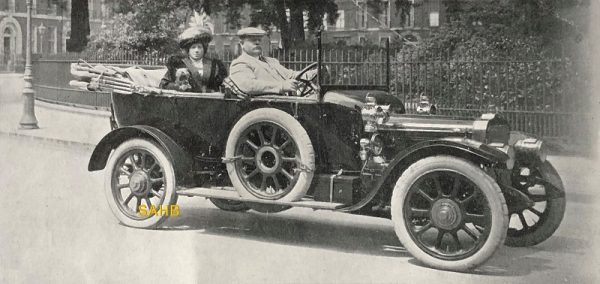
Gustave Adolphe Clément (1855-1928) was an entrepreneur who in 1876 started building bicycles and went on to race and manufacture bicycles, pneumatic tyres, motorcycles, motor cars, aeroplanes and airships. Clément invested in the Gladiator Cycle Company, a French bicycle manufacturer, founded by Alexandre Darracq and Paul Aucoq in 1891. Their first motorised vehicle, a naphtha-powered tricycle, was introduced in 1895. By 1898, the Clément-Gladiator company was building cars and marketing them as both Cléments and Gladiators.
Clément-Gladiator was divided in 1903. Charles Chetwynd-Talbot founded the English arm Clément-Talbot Ltd, while Clément formed Clément-Bayard on a former military site at Mézières. Clément-Talbot was formally incorporated in 1902 and from 1903 imported Clément-Bayard cars. They purchased land in west London to build a modern factory in what became Barlby Road, and from 1905 produced the first British-assembled cars. Although the company was always known as Clément-Talbot until its takeover by the Rootes Group in 1938, after the first year of trading the cars were always known as Talbots.
The first truly British-built Talbots emerged from the factory in 1906. In 1910 Talbot announced the 25 HP six-cylinder car that we see here; it was aimed at advancing Talbot into the same league as the six-cylinder Napier and Rolls-Royce products. The 3.6-litre, six-cylinder engine drove through a four-speed gearbox.
This powerful large car was an entirely appropriate mount for the driver in our Snapshot, the German-born strongman William Pagel, born in 1878. Christened Frederich Wilhelm August Pagel, he was the second of eight children. As a lad he left Germany to become a sailor, but soon settled in Australia and at the age of nineteen, already tall and well-built, was working in a restaurant, peeling potatoes, washing dishes and, most importantly, acting as a bouncer. Around 1902, Wilhelm joined the Worth Brothers Circus in Australia as a strongman. In February of 1905 he sailed to Durban, South Africa, where he set up at agricultural shows, topping the bill as a strongman and also highly respected as an animal trainer, presenting a thrilling lion-taming act. His signature feat was to carry a 1,050-pound horse, slung below him, up two vertical eighteen-foot ladders placed side by side – doing this up to ten times a day.
Pagel married a small woman thirteen years older than himself, Mary Dingdale, born in 1865 in Leeds – no doubt the passenger in our picture. Mrs. Pagel died in December 1939 at the age of seventy-four but Pagel was still performing with lions in 1948 at seventy years of age and died that same year.
Image courtesy of The Richard Roberts Archive: www.richardrobertsarchive.org.uk







Leave a Comment